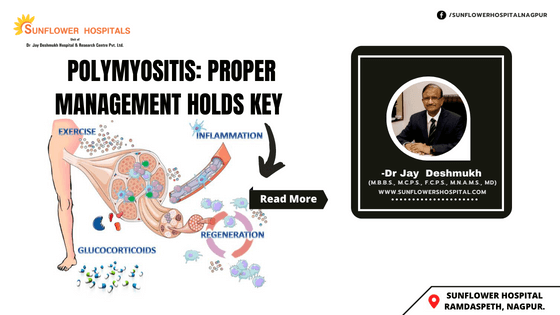What is dermatomyositis?
When muscle involvement is accompanied by skin involvement, then it is known as dermatomyositis. There is a reddish rash on the front of the chest, around the eyes, and the shoulder areas.
Can Polymyositis and dermatomyositis be accompanied by cancer?
Certainly, few patients with this autoimmune disorder can also have cancers associated with the breast, lungs, ovaries, colon, and lymphoma. In fact, sometimes the muscle weakness may ante-date underlying cancer by a few months. So in all patients with dermatomyositis, cancer screening is always advisable.
What causes polymyositis?
The exact cause remains elusive. However, hereditary may play a role. Antibodies are formed against the person’s muscles. This causes inflammation and weakness of the muscles. The proximal muscles of the body, which include thigh muscles and arm and shoulder muscles, are generally affected. Raising hands above shoulder levels and getting up from a sitting position becomes difficult. Muscles can become painful and tender. There could be shortness of breath due to heart and lung involvement. Difficulty in swallowing, fever, and weight loss are the companies.
What are the skin manifestations?
Patchy red or violet rashes on the face, particularly around the eyes, knees, elbows, knuckles, and neck. Tipper’s chests are common.
How is polymyositis diagnosed?
Certain blood tests for muscle inflammation like CPK, SCOT, and LDH are necessary. Blood for ANA may be positive. Inflammatory markers like ESR and CRP may be raised. The typical involvement of proximal muscles of the body and the skin rash in a female wound raise the suspicion of dermatomyositis-Polymyositis is inflammation of muscles. This leads to muscle weakness. Rising up from a sitting position or raising hands, climbing stairs, or reaching overhead are the main symptoms. This is more common in women than in men. The muscles gradually deteriorate over a period of time, enormously. Nerve conduction studies and Electro Geography support the diagnosis. Muscle inflammation and the type of myositis are confirmed by muscle biopsy. Tests for asymptomatic cancers of the breast, lungs colon, and ovaries are necessary for all patients. A test for lymphoma is necessary.
Are there any risk factors for polymyositis?
This is seen more commonly in women than men. Individuals with underlying lupus, rheumatoid arthritis, scleroderma, or Sjogren’s disease are more vulnerable.
How is the disease treated?
Being an autoimmune disorder, there is no absolute cure. One can control this disorder. Steroids are given initially to control the inflammation. Later, immunosuppressants are given. These may include Azathioprine, Mycophenolate, Macrolides, Ciclosporins, or Rituximab. In some cases, intravenous infusions of immunoglobulins are given. Physiotherapy is an important aspect of treatment. Intermittent flares are treated with steroids.
What are the associated features or complications?
In cold weather, the fingers, toes cheeks and nose may turn pale. This is known as Reynaud’s phenomenon. Sometimes the muscles of the heart may become weak. This may be associated with heart failure or irregular heart rhythm. Lung stiffness and fibrosis can occur. All individuals with this disorder should be adequately vaccinated. Polymyositis and dermatomyositis are unique autoimmune disorders. They require diligent care which includes steroids, immunosuppressants, and physiotherapy to strengthen muscles. Though there is no cure, proper management can help individuals to lead almost normal life.
Author: Dr Jay Deshmukh
Dr Jay Deshmukh is Chief Physician and Director, Sunflower Hospital, Nagpur Honorary Physician to Honorable Governor of Maharashtra and PondicherryCentral. Dr Jay Deshmukh is an M.B.B.S., M.C.P.S., F.C.P.S., M.N.A.M.S., MD From Internal Medicine – Bombay and New Delhi.


